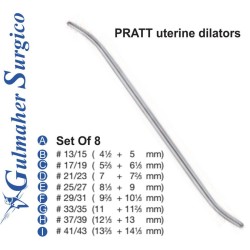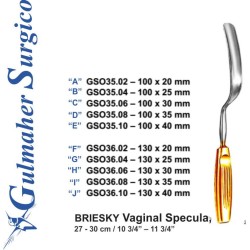-1060x400w.png)
In every
surgical procedure, precision, visibility, and control are extremely important.
To achieve this, surgeons rely on a wide range of gyno tools, surgicalretractors, and different types of surgery instruments designed for
specific tasks. Whether it'sgynecology, general surgery, plastic surgery, or
emergency care, proper instruments help improve accuracy and reduce
complications.
In this
blog, we explore the most commonly used instruments such as Army Navy
Retractor, Deaver Retractor, Anal Speculum, Crile Forceps,
Thumb Forceps, and Finochietto Retractor, along with their uses
and importance.
1. Gyno Tools: Instruments Essential for
Gynecological Procedures
Gynecology
requires delicate and highly precise instruments. Gyno tools are
specially designed to assist doctors in examining and treating female
reproductive organs with maximum comfort and safety.
Common Gyno Tools Include:
- Speculums
(metal or plastic) used for vaginal examination
- Forceps for
grasping tissues
- Scissors for
cutting or dissecting
- Retractors for
holding tissues apart
These
tools help gynecologists perform examinations, biopsies, suturing, minor
surgeries, and childbirth-related procedures efficiently.
2. What Are Surgical Retractors?
A retractor
is a surgical instrument used to hold back tissues, organs, or incisions
so the surgeon has a clear working area.
Retractors are essential in almost every surgical specialty because they:
- Improve
visibility
- Reduce
tissue damage
- Give
the surgeon more control
- Allow
hands-free operating when self-retaining retractors are used
Retractors
come in different shapes and sizes depending on the surgical need.
3. Army Navy Retractor: A Must-Have in Every Surgical
Kit
The Army
Navy Retractor is one of the most commonly used hand-held retractors.
It has a simple double-ended design, making it easy to use in multiple
procedures.
Key Features:
- Straight
and flat design
- Two
blades of different sizes
- Lightweight
yet strong
Common Uses:
- General
surgery
- Tissue
retraction in small incisions
- Abdominal
and orthopedic procedures
Its
simplicity, versatility, and durability make it a favourite among surgeons.
4. Deaver Retractor: Ideal for Deep Cavities
The Deaver
Retractor is a large, curved retractor used to hold back deeper organs and
tissues.
Where is Deaver Used?
- Abdominal
surgeries
- Liver
and stomach procedures
- Gynecology
and pelvic operations
Its
curved blade helps surgeons reach deep surgical sites without damaging soft
tissues.
5. Anal Speculum: For Rectal Examination &
Procedures
The Anal
Speculum is an essential diagnostic tool used to open and examine the anal
canal.
Uses of Anal Speculum:
- Hemorrhoid
inspection
- Anal
fissure examination
- Minor
rectal procedures
- Biopsies
It
provides comfort to the patient while giving the doctor a clear view of the
area.
6. Crile Forceps: A Multi-Purpose Clamping
Instrument
The Crile
Forceps (also called hemostats) help control bleeding and handle tissues.
Features:
- Curved
or straight design
- Full
serration for strong grip
- Locking
mechanism
Uses:
- Clamping
blood vessels
- Holding
tissue
- Dissection
during surgeries
Crile
Forceps are essential across all medical fields including gynecology, plastic
surgery, and general surgery.
7. Thumb Forceps: Precision for Delicate Movements
Thumb Forceps, also known as tissue forceps, help
surgeons hold, pull, or manipulate tissues with accuracy.
Applications:
- Suturing
- Dressing
wounds
- Handling
small tissues
- Plastic
and cosmetic procedures
These
forceps come in toothed and non-toothed versions depending on the type of
tissue.
8. Retractor Surgery: Why Retractors Matter
"Retractor
surgery" refers to any procedure where retractors are used to hold
tissues open.
Benefits of Using Retractors:
- Better
visualization
- Safer
incisions
- Faster
surgical time
- Reduced
complications
From
simple incisions to complex abdominal surgeries, retractors make operations
safer and more effective.
9. Finochietto Retractor: The Chest Surgery
Specialist
The Finochietto
Retractor is a self-retaining instrument mainly used in thoracic surgery.
How It Works:
- Mechanically
spreads the ribs
- Provides
a stable, wide-open surgical field
Common Uses:
- Heart
surgery
- Lung
procedures
- Other
thoracic operations
Its mechanical
design allows the surgeon to work hands-free, improving efficiency during major
surgeries.
Conclusion
From gyno
tools to advanced retractors, each surgical instrument plays a vital
role in ensuring precision and safety. Instruments like the Army Navy
Retractor, Deaver, Anal Speculum, Crile Forceps, Thumb
Forceps, and Finochietto Retractor are essential parts of modern
surgical kits.
Using the
right surgical instruments not only improves outcomes but also enhances
patient comfort and recovery.



%20(1)%20(1)-250x250h.jpg)
Leave a Comment